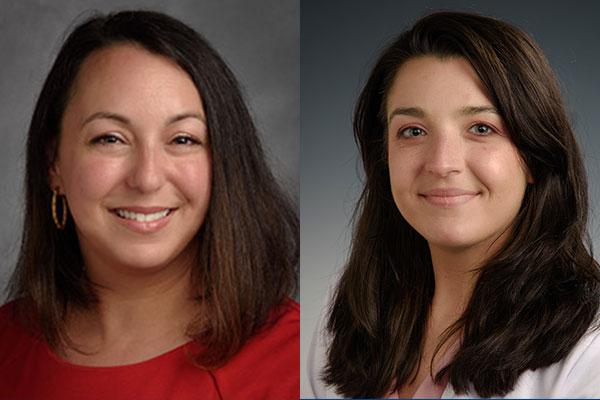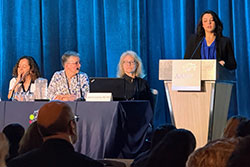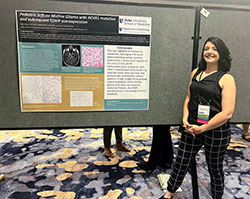
Associate Professor Karra Jones, MD, PhD, and third-year Pathology Resident Emily Teague Smith, MD, presented talks and posters at the American Association of Neuropathologists (AANP) 101st Annual Meeting in Minneapolis, Minnesota, June 18-22, 2025.
Smith was selected as one of only 11 trainees to give a prestigious "Diagnostic Slide Session" (DSS) presentation. DSS is a special session at the AANP meeting where trainees, usually fellows, present complicated unknown cases, and neuropathologists present their thoughts on the differential diagnosis and workup of the case.

Smith presented a difficult muscle biopsy case that had been sent to Jones in consultation from Vanderbilt University School of Medicine due to its complexity. The muscle showed membrane-bound compartments called vacuoles and, using Duke’s high-level muscle biopsy testing, they recognized that there was excess glycogen. Much of it was bound in membranes/lysosomes, and there was evidence of autophagic vacuoles. Autophagic vacuoles are important in muscle health, and the abnormal accumulation of them pointed to a glycogen/lysosome disorder, most specifically Pompe disease. The team at Vanderbilt was able to perform genetic testing and confirm that indeed it was Pompe disease, which allowed the patient to undergo enzyme replacement therapy. The DSS cases can be seen here, and include a whole slide image. (Smith’s case is the sixth listed.)
“Emily did a really amazing job presenting the case and handling discussions from the neuropathology audience,” said Jones.
Smith was the primary author of the poster she presented, "Pediatric Diffuse Midline Glioma with ACVR1 Mutation and Subsequent EZHIP Overexpression," co-authored by Jones and David Ellison, MD, PhD, (St. Jude's Children's Research Hospital). She covered a child’s case of a diffuse midline glioma–a rare and aggressive brain tumor. These tumors usually have a mutation in a histone gene that leads to overexpression of a protein called EZHIP, a protein-coding gene involved in epigenetic regulation, or how genes are turned on or off without altering the DNA sequence. However, in this case, the common gene mutations were absent. Instead, it had a very rare mutation in an unusual gene (ACVR1) that led to an alternative pathway of EZHIP protein overexpression.
Her case required consultation with Ellison to perform immunostaining for EZHIP at St. Jude's Children's Research Hospital, a test available at only a few institutions nationally.
“These unusual findings made the diagnosis more challenging than usual,” said Jones. “We wanted to share this rare situation with others in case they run across it.”

Jones’ poster, "Adult Polyglucosan Body Disease Neurodegeneration with Associated Liver Disease: An Autopsy Study," reflected her collaboration with Duke’s Pediatrics and Medical Genetics team that is studying glycogen storage diseases, including co-authors Fiona Weaver, Priya Kishnani, MD, MBBS, and Rebecca Koch, PhD, RDN.
The team has a biorepository for patient samples from all forms of glycogen storage diseases, which they use in an effort to understand an extremely rare disease: Adult Polyglucosan Body Disease (APBD). This inherited disease is a neurological disorder that affects the nervous system.
“Patients and their families have been very gracious and supportive to donate tissues post-mortem,” said Jones. “We’re working to analyze these to better understand the disease process.”
The abstract described brain autopsy findings from two patients with APBD. The Research Foundation in APBD assisted with funding for the project.
Jones serves as chair of the AANP Education Committee and sits on its Executive Council as the assistant-secretary treasurer. In her work with the AANP, she and others on the Education Committee assist the organization’s president and vice president with planning and implementing educational content for meetings. Planning is already underway for the 2026 Annual Meeting in Cambridge, Maryland.
Jones is the medical director of Duke’s Clinical Electron Microscopy and Immunochemistry Laboratory. She also serves as section head of Muscle & Nerve Pathology; and as director of the Neuropathology Fellowship Program.